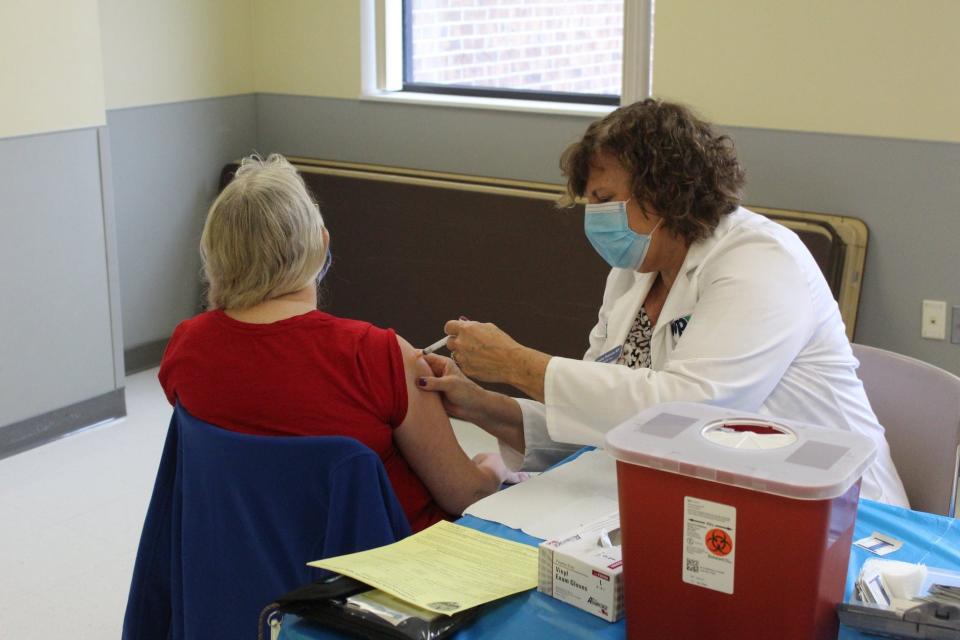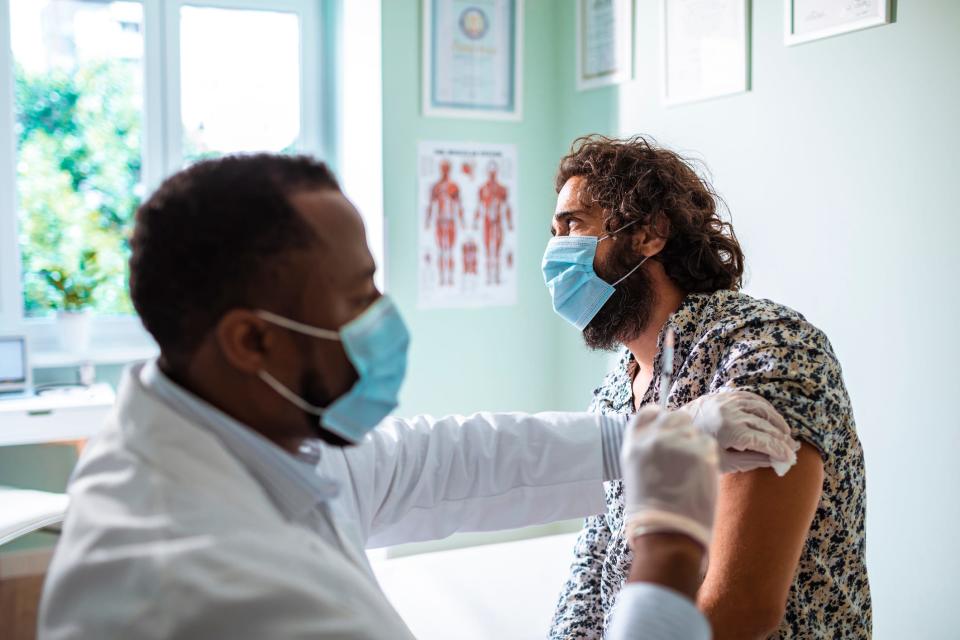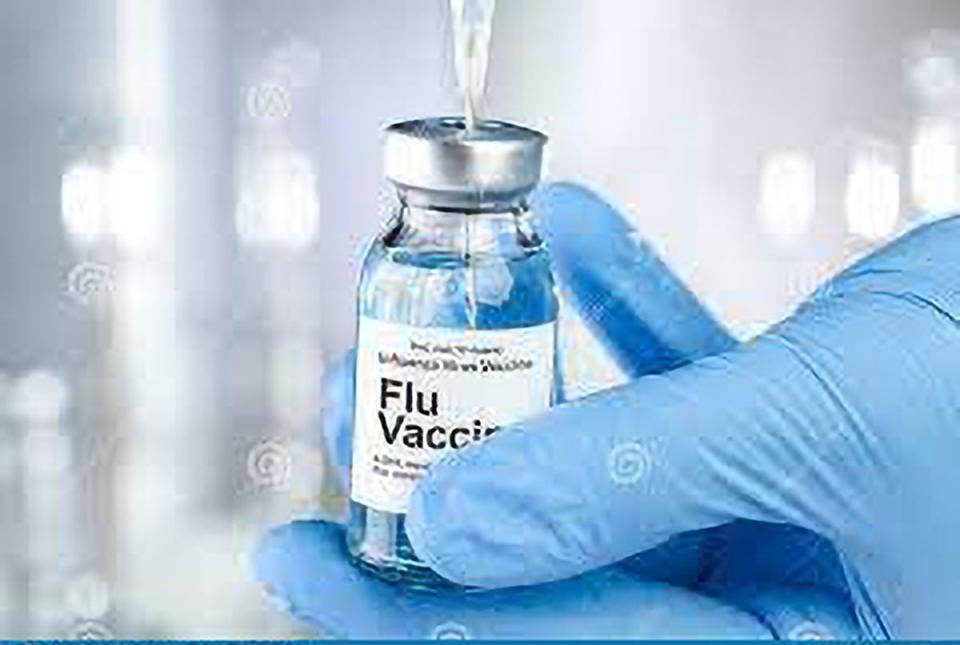As COVID surges, New York's flu season is off to a troubling start. Will 'twindemic' hit?
New York’s flu season is off to a troubling start after the influenza virus all but disappeared last season amid COVID-19 restrictions, state data show.
The tally of flu cases this season was 1,585 after recent spikes in some counties, including outbreaks potentially linked to Halloween parties on college campuses, according to a health official and the most recent state data through Nov. 13.
In contrast, the flu case count was about 870 and 570 at the same point during the two flu seasons before the pandemic-skewed 2020-21 season.
Syracuse University Chancellor Kent Syverud addressed the rising flu threat on the central New York campus during a university senate meeting Wednesday, noting COVID-19 cases remained low at the college in Onondaga County.
Syverud told the senate that “there’s every indication that, unlike last year when flu was at an historic low because of COVID precautions, this year is going to be a challenging year for the flu,” the college reported.

The flu's return in New York came as federal health officials descended on the University of Michigan, aiming to help control a flu outbreak of 528 cases on the Ann Arbor campus, USA TODAY Network reported.
Dr. Joseph Sellers, president of the Medical Society of the State of New York, said it is too early to determine how bad New York’s flu season would get, but he urged people to get the flu shot based on the early statistics.
“The most important thing to keep in mind is our health system is already stressed and filled with fatigued workers,” he said, citing the growing wave of COVID-19 patients.
“Hospitals don’t need even more of a burden with people who are sick with influenza,” he added, describing widespread use of the flu vaccine, mask wearing and hand washing as crucial to curbing the virus’ spread.
More: New York's nurses have endured the unimaginable. Here's how they're still fighting COVID
What to know about New York’s flu season

To understand New York’s flu warning signs this season, consider the statewide tally overall last season was about 4,900 cases.
By contrast, the flu count totaled nearly 158,000 cases in 2019-2020, a record high and up from 108,000 the prior season, state data show. Strikingly, the current season is outpacing both of those seasons so far.
Further, flu-related hospitalizations during those prior seasons topped 15,500 statewide, underscoring the potential fallout for New York hospitals if cases spike this season. Nationally, the flu kills thousands of Americans each year, with a recent high of 52,000 deaths in 2017-18, federal data show.
Meanwhile, experts attributed last season’s drop off in cases primarily to mask wearing, social distancing and remote learning. But flu vaccinations nationally also reached a record high during the period.
More: Common colds are back in NY as masks come off and COVID precautions loosen
Nearly 194 million doses of flu vaccine were distributed nationally last season. By contrast, about 163 million doses had been distributed this season through Nov. 5, the latest federal data show.
The drop in flu vaccinations this year came as authorities rolled out a historic campaign to vaccinate Americans against COVID-19.
Still, health officials spent recent months sounding the alarm about the potential for a "twindemic" of COVID-19 and flu, as both are respiratory illnesses with some overlapping symptoms.
The public health alerts, and flu vaccination push, unfolded as the highly contagious COVID-19 delta variant spread during the lead up to flu season, which typically starts in October, peaks in February, and ends in May.
Last season, New York had a statewide flu vaccination rate of about 56%, according to Kaiser Family Foundation. The percentage reflects all New Yorkers older than 6 months, as the flu vaccine is not approved for children under 6 months.
About 50% of adults in New York City received the flu shot, with disparities among racial and ethnic groups for adults 18 and older, the city health department reported.
In New York City, Black adults reported flu vaccine coverage at 44%, Hispanic adults at 52%, White adults at 51% and Asian/Pacific Islanders at 57%.
The state Department of Health did not immediately respond last week to questions about the current flu season’s vaccination rate. By contrast, Michigan has a website that publicly releases real-time data about flu vaccination rates in that state.
What New York is doing about flu

Abigail Barker, a Health Department spokeswoman, noted the state agency collects and analyzes a range of information about flu activity statewide.
New York officials have also promoted vaccination against both influenza and COVID-19, Barker said in a statement, citing how Gov. Kathy Hochul released a public service announcement as part of the effort on Oct. 13.
“The COVID-19 vaccine and/or a booster dose can be received at the same time as the seasonal flu shot,” Barker said.
More: NY hospitals filed 4,880 liens against homes of patients for unpaid medical bills: report
“The flu shot remains the best way for people to protect themselves and their families from the flu,” she added.
Outside New York City and Long Island, some of the counties with higher flu case counts so far this season included Onondaga (182), Westchester (87), Tompkins (74) and Monroe (35), state data show.
Melanie Drotar, an Onondaga County health department spokesperson, said the uptick in Onondaga's flu cases may be linked to "a post-Halloween increased transmission among the college-aged population."
State and local health officials were working with area Onondaga County colleges to increase early diagnosis and vaccinations to curb flu outbreaks, Drotar added in a statement.
The flu case count for Saratoga County was 101, state data show, but local health officials said the number was inaccurate due to false positives and would soon be corrected.
Meanwhile, New York and national flu counts do not represent the full scope of the virus’ spread, in part, because it only includes laboratory-confirmed cases, excluding undiagnosed cases and clinical diagnoses.
For example, a Syracuse University official on Wednesday said the campus was averaging 40 to 50 flu cases per day, according to The Daily Orange. But Onondaga County’s reported flu tally was only 182 cases total through the season’s first six weeks.
By contrast, Syracuse University reported 82 COVID-19 cases on campus between Oct. 20 and Nov. 19. The college required all students, faculty and staff to get vaccinated against COVID-19 and flu, according to its website.
Historically, flu vaccines effectiveness at preventing infection has averaged around 40% over the past 15 years, federal data show, but those getting the shot generally face milder cases overall.
in contrast, the Pfizer-BioNtech and Moderna vaccines against COVID-19 initially reported efficacy above 90%. The two vaccines continue to limit serious illness, but waning protection against breakthrough infections prompted New York to expand booster shots to all adults who got shots at least six months prior.
Despite New York City having comparatively lower COVID-19 infection rates than upstate counties, it accounted for its fair share of flu cases, at 436 so far. Long Island added another 284 flu cases to the statewide tally.
Yet beyond the twindemic concerns, Sellers, whose society represents thousands of doctors statewide, noted experts have suggested the flu could pose a unique challenge this season for public health.
For example, the flu virus’ disappearance last season may have left the population’s immunity vulnerable to a resurgence.
Flu case counts could also be difficult to compare to prior years due to increased testing for respiratory disease symptoms, in general, amid COVID-19 concerns.
Yet, experts agree one of the best tools to limit flu remains boosting vaccination rates.
“If we wait to see how bad influenza is going to be, the horse is out of the barn,” Sellers said, “We need to do this now.”
For further details about finding the flu vaccine, visit the vaccines.gov website, or call 1-800-232-0233.
Support local journalism
We cover the stories from the New York State Capitol and across New York that matter most to you and your family. Please consider supporting our efforts with a subscription to the New York publication nearest you.
David Robinson is the state health care reporter for the USA TODAY Network New York. He can be reached at drobinson@gannett.com and followed on Twitter: @DrobinsonLoHud
This article originally appeared on New York State Team: Will NY's flu season be bad? Early outbreaks raise 'twindemic' alarms

